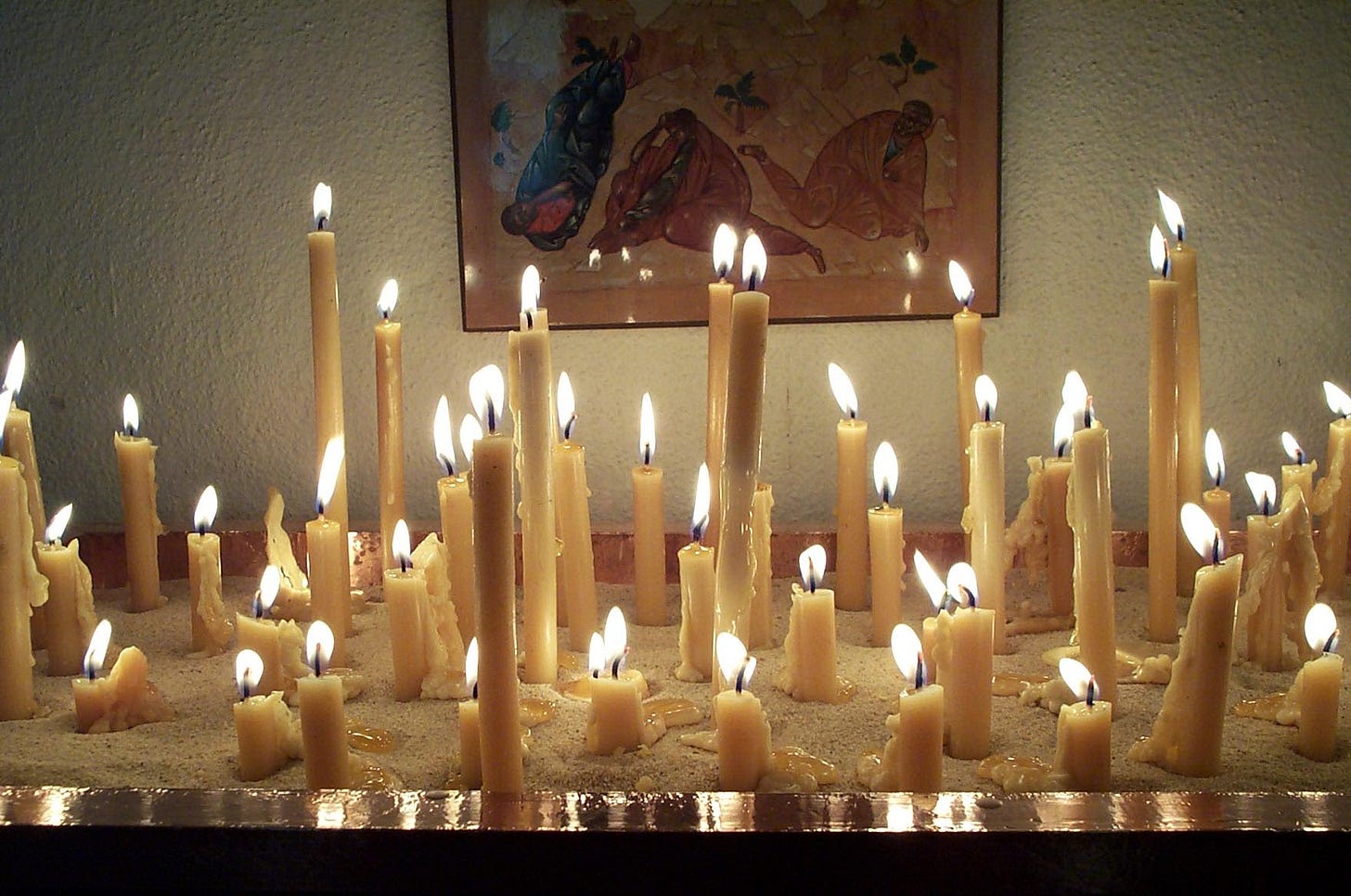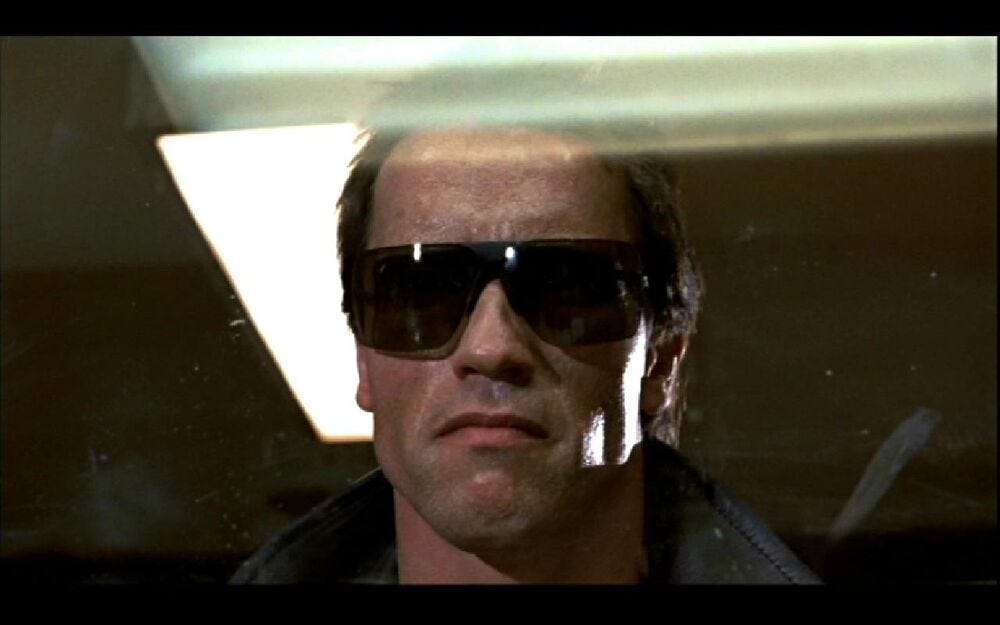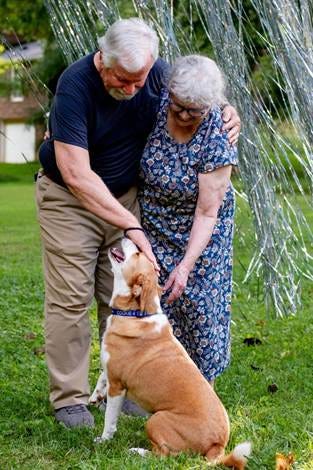The icon of Christ’s Transfiguration made me remember a — a photoshoot, I guess you’d call it. I had this idea for a photo, with a forest of candles burning before an icon. I wanted to use the bottom of a Transfiguration icon, because it shows the Apostles tumbling down, and I thought that would be intriguing, especially to those who don’t know what’s going on there.
You’ve no doubt seen many multi-candle photos like this, evocative of an Orthodox setting, but I think I was the first person to do it; I had never seen it anywhere else. It was February, 2010. I took a score of photos, from different angles, but didn’t really have a place to use the image. A friend who had seen it asked if he could make a similar image for a book jacket, and after that I saw versions of it popping up here and there.
I took the photo in Holy Cross Orthodox Church, where this wooden sand box with a beautiful copper lining was near the door. Seraphim O’Keefe had not covered the walls with icons then, not till 2012-14. I had to move the Transfiguration icon from somewhere else to get it in the right place.
One thing I learned is man, it gets HOT! It is really, really hot, being around that many candle flames. So every time I see a scene in a movie where the amorous couple are surrounded by lots and lots of irrelevant candles, I know that it’s really hot for them in a temperature sense, even though they’re acting very comfortable and, well, amorous.
My husband & I watched “The Terminator” for the first time last night. When there were extended fight and car chase scenes, I just waited till they were over. I was waiting for the plot to advance, and the minutes spent on these scenes just had to be endured. My husband didn’t feel that way.
And the gross stuff! I know it’s fake, but I still don’t want to see it. When the cyborg was using a utility razor to deal with a damaged eye, I just put my hands over my eyes, but I peeked through my fingers to keep an eye on his ear, because once the camera moved elsewhere it probably wouldn’t be as gross.
I thought the characters of Sarah Conner and Kyle Reese were very well done. [SPOILERS] When she is in the police station and has just learned that her roommate is dead, she weeps, and that’s just plain realistic. But most movies skip over that sort of detail because it’s not directly relevant to the plot. And when she asked Kyle what her character in the future is like, as he tells her all he admires, she says thoughtfully, “I’m not like that.” There were just some really good notes like that.
Everyone (almost everyone) seems to think that “Terminator 2” is better, so I’ll have to see that one too. What are some other movies, or books, where the sequel was better than the first? “Bill and Ted’s Bogus Journey” was better than “Excellent Adventure” I think. Others?
I received a long, thoughtful comment from someone who wanted to understand how Christ’s Victory in Hades took care of the debt we owe God for our sins. She supplied many quotations from Athanasius, the brilliant young theologian at the First Ecumenical Council in 325. It was a good and interesting comment, so I wanted to post my reply here:
<< Thank you for such a good comment! So well-fleshed-out and supported from Athanasius and Scripture. But I think there’s something I can explain about Orthodoxy, and dear Athanasius himself, that can help. (He was only 21 when he wrote On the Incarnation! I hope you are reading the St Vladimir’s Press version that has a foreword by CS Lewis.)
The slight adjustment is that sin infects us with Death. We begin to rot. We begin to decompose, and the more we sin, the more this condition speeds up, and the more confused we get about how to return, and the more our souls break down. It is a process of hideous disintegration. While yet alive, we begin to (spiritually speaking) smell like a corpse.
It’s an organic, inherent process, rather than law-breaking. In a way, the Anselm-Protestant view doesn’t take sin seriously enough. It treats sin as if it is something outside us. We can get a speeding ticket that takes a point taken off our drivers’ license, then pay a fine or take a course and get it removed, but the person underneath is unchanged. That’s not the case, with sin; instead, we begin a process of decomposition.
God can’t take a stinking corpse into his Kingdom. He is Lord of Life, and Death cannot exist there. God is not going to adjust Kingdom standards so Death is now OK.
We had our son Fr Stephen’s dog staying with us for a week, and I’m usually not much of a dog person, but I love Cookie. I don’t think there’s any dog as inherently loveable as Cookie.
But one of those days, when we brought her in the house, there was a notable bad smell; apparently, she had rolled in something. My husband took her outside and washed her off, and then she was more than welcome inside.
We never stopped loving Cookie. We loved her even when she smelled bad. But we could not have the smell of death (or whatever it was) inside our house. She could not come into the house until her ear and shoulder were cleansed; and, for us humans, that means when our souls are cleansed from sin, and we no longer carry about with us the stink of Death.
God forgives our sins, and absorbs that horrific cost into himself—but that doesn’t fully solve the problem. It restores us to him, but it doesn’t yet heal us. Life in the Orthodox Church is a course of therapy, healing us from the wounds of sin.
God isn’t wrathful; you wouldn’t be wrathful at your child for getting sick. The father of the Prodigal was not wrathful. God loves us, and that makes all the difference. He has pity on us. He wants us to be healed and come home.
“As I live, says the Lord God, I have no pleasure in the death of the wicked, but rather that the wicked turn from his way and live. Turn, turn from your evil ways, for why will you die, O house of Israel?” (Ezekiel 33:11).
Athanasius is writing primarily about the Incarnation, of course, and it encompasses the Atonement. When I was newly Orthodox I asked many people what I should read to understand the Orthodox theory of the Atonement. And people kept telling me to read “On the Incarnation.” And I would say “I’m not asking about the Incarnation. I want to understand the Atonement.” But when I read it, the logic became evident.
The first thing Jesus does for our salvation is become human; Athanasius says, like when a king visits a city, it brings honor to the whole city, even though he dwells in only one house. Jesus’ entry into human flesh brings to shared humanity a fresh infusion of life and health. We can grow stronger against sin. We can begin to return to life.
On the Cross he goes into direct combat with the evil one. We Orthodox can say, OK, it’s a substitutionary atonement, in the sense that he substitutes for us in single combat with the evil one, like David substituted for all Israel in single combat against Goliath. When Christ died on the Cross, the evil one thought he had won. But in Hades our Lord revealed his glory, and reclaimed from Death all the righteous who had gone before.
As I reread all the Scriptures you supplied, and the passages from Athanasius, it seems to me that when we view the damage of sin as (in a sense) organic, it gives a whole different way to understand their meaning. You’ll find it in Orthodox worship, expressed in a million ways. It’s a beautiful, joyous realization to know that God was not enraged at us, but yearned for us like the Father of the Prodigal. His Son came to wrest us back from the grip of Death, and restore us to his Father’s Kingdom.
Hope this helps!>>







Thank you for yet another great read. I enjoy your writing style and appreciate you taking the time to share…
Thank you! Truly appreciate your teaching on this!